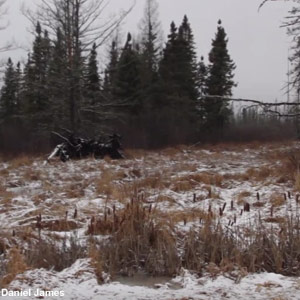Magazine | Voyages
Le Sax-Zim bog, un bout de taïga aux États-Unis

Une vue du Sax-Zim bog (Minnesota) en hiver, un très bon site pour observer entre autres la Chouette lapone.Source : Daniel James
Introduction
Le Minnesota est l’état américain le plus nordique en dehors de l’Alaska, son extrémité nord-ouest s’étendant au nord du 49ème parallèle. Il est bordé au nord par les provinces canadiennes du Manitoba et de l’Ontario. La taïga atteint le nord de cet état, et les zones humides (tourbières et lacs) y sont nombreuses. L’hiver est froid et long. Du fait de sa situation géographique, le Minnesota est une destination prisée des ornithologues américains souhaitant observer les espèces boréales obligées de quitter en hiver la forêt boréale canadienne. Le Sax-Zim bog est une tourbière boisée située à trois heures de route au nord de Minneapolis-Saint-Paul et à environ 50 km au nord de Duluth : c’est l’un des meilleurs sites des États-Unis (hors Alaska) pour observer en hiver certains oiseaux nordiques comme les Chouettes lapone et épervière, la Buse pattue, le Mésangeai du Canada ou le Durbec des sapins. Le cortège des oiseaux nicheurs est aussi très intéressant, incluant notamment le Pic à dos noir, le Tétras à queue fine et la Mésange à tête brune.
Après une présentation de ce secteur et de son avifaune, nous vous proposons un exemple de circuit ornithologique mis au point par l’association « Friends of the Sax-Zim » et qui vous permettra d’observer la plupart des « spécialités » ornithologiques du Sax-Zim bog.
Abstract
Minnesota is the northernmost US state, with the exception of Alaska, its northwestern tip extending north of the 49th parallel north. It is bordered by the Canadian provinces of Manitoba and Ontario. The taiga reaches the north of this state, and wetlands (peatlands and lakes) are numerous. Winter is cold and long. Because of its geographical location, it is a popular destination for American birds wishing to watch several boreal species that leave more northern areas in winter. The Sax-Zim bog is a wooded area located three hours north of Minneapolis-St. Paul and about 50 km north of Duluth. It is one of the best sites in the United States (outside Alaska) to watch in winter some northern birds such as the Great Grey and the Hawk Owls, the Rough-legged Hawk, the Grey Jay and the Pine Grosbeak, and the breeding species include the Black-backed Woodpecker, Goshawk, Black-tailed Grouse and Brown-capped Chickadee.
After a presentation of this area and its avifauna, we propose an example of an ornithological circuit developed by the « Friends of the Sax-Zim » association and which will allow you to observe most of the birding « specialties » of the Sax-Zim bog.
Poursuivez la lecture de cet article, en vous abonnant dès maintenant !
Découvrez les Archives d’Ornithomedia.com
Pour seulement 10,00 €TTC/an (ou 6,00 € les 6 mois)
Profitez de plusieurs centaines d’articles en accès illimité et sans aucun engagement.
Compléments
À lire aussi sur Ornithomedia.com
- Observer les oiseaux à Chicago : le Montrose Point Bird Sanctuary
- Observer le Harfang des neiges en hiver dans le sud-est du Québec
- Séjour ornithologique automnal dans l’archipel de Saint-Pierre et Miquelon
- Observer les oiseaux dans l’archipel de Saint-Pierre et Miquelon
- Où observer les oiseaux dans les Laurentides (Canada) ?
À lire sur le web
- Le site web de l’association « Friends of the Sax-Zim » : http://saxzim.org
- Le site web du Sax-Zim Bog Birding Festival : www.saxzimbirdingfestival.com
Ouvrages recommandés
- Guide Sibley des Oiseaux de l’Est de l’Amérique du Nord de Sibley David Allen
- Guide d’identification des oiseaux d’Amérique du Nord. 3ème édition de National geographic society
Sources
- Jim Williams (2015). Sax-Zim Bog, Meadowlands, Minnesota. Birdwatchingdaily. www.birdwatchingdaily.com/hotspots/222-sax-zim-bog-meadowlands-minnesota/
- 365 Days of Birds. Northern Minnesota Birding Locations. www.365daysofbirds.com/northern-minnesota-birding-locations




Aucun commentaire sur ce sujet
Participer à la discussion !